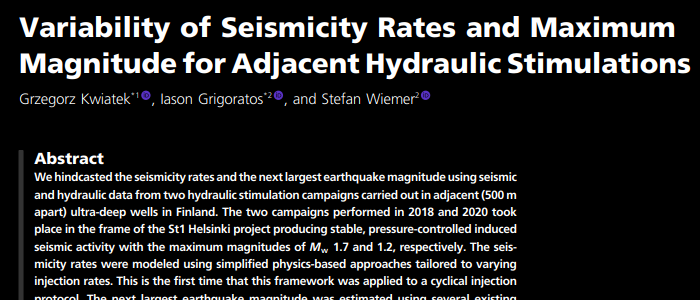Together with Iason Grigoratos and Stefan Wiemer from ETH Zurich we published a manuscript in Seismological Research Letters entitled “Variability of Seismicity Rates and Maximum Magnitude for Adjacent Hydraulic Stimulations“. In the paper we analyzed seismicity rates and predicted the next largest earthquake magnitude using seismic and hydraulic data from two hydraulic stimulation campaigns in ultra-deep wells in Finland, 500 m apart. Conducted in 2018 and 2020 as part of the St1 Helsinki project, these campaigns induced controlled seismic activity with maximum magnitudes of 1.7 and 1.2. We used simplified physics-based models tailored to varying injection rates and applied this approach for the first time to a cyclical injection protocol. Our results revealed significant differences in model parameters between the two stimulations, despite their proximity. These differences likely arose from varying hydraulic energy rates, slight variations in fracture network characteristics, and differences in injection protocols. While the seismicity rate model performed well for the 2018 campaign, it struggled to fit the 2020 data. Predictions for the next largest magnitude varied widely across models, with their relative accuracy differing between campaigns. Notably, the best-performing model for 2018 was the least accurate in 2020, highlighting challenges in using a priori seismic hazard parameters for nearby stimulations
Highlights:
- We forecast seismicity rates and next largest earthquake magnitudes using hydraulic data from two hydraulic stimulations at St1 Helsinki performed in adjacent wells
- Critical components of the seismicity rate model differ significantly between the two stimulations despite their close proximity
- Forecasting the next largest magnitude using different models led to a wide range of outcomes that are inconsistent across stimulations
Reference:
Kwiatek, G., I. Grigoratos, and S. Wiemer (2024). Variability of Seismicity Rates and Maximum Magnitude for Adjacent Hydraulic Stimulations. Seismological Research Letters, DOI: 10.1785/0220240043. [ Article Page ]
